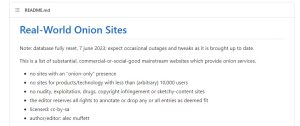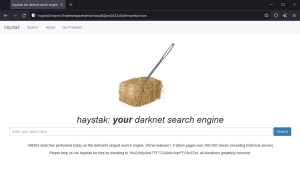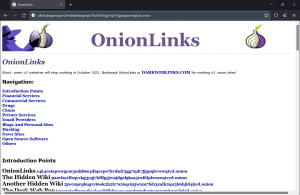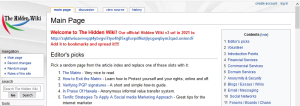How to Find Active .Onion Sites
In the digital age, the internet is a vast expanse, but beneath its surface lies an even deeper realm known as the Dark Web. This enigmatic part of the internet consists of .onion sites hosted on the Tor network, accessible only through specialized means. If you’ve ever wondered how to navigate this hidden landscape and find active .onion sites, you’re in the right place. In this guide, we’ll delve into the intricacies of the Dark Web and reveal the secrets to safely uncovering its treasures.
The Tor Network: Unveiling the Dark Web
Before we embark on our journey to find active .onion sites, let’s shed some light on the Tor network and its unique characteristics. Tor, short for “The Onion Router,” forms a web of interconnected nodes, offering users unparalleled anonymity on the internet. Within this network lies the mysterious realm of .onion sites, characterized by their distinctive top-level domain suffix.
Accessing the Unreachable
.onion sites are not accessible through your regular web browser. They are part of the “invisible internet,” often referred to as the deep web. To unlock the secrets of .onion sites, you must embrace the Tor browser, a modified Mozilla Firefox browser equipped with advanced scripts and add-ons that safeguard your online privacy.
The Tor browser comes preconfigured to connect seamlessly to the Tor network, and it’s crucial to resist the temptation of tweaking its settings unless you possess a deep understanding of the consequences. Altering the Tor browser’s settings recklessly could jeopardize your private browsing data’s security.
To begin your journey, visit the Tor Project’s official website and download the Tor browser. Once downloaded, locate the Tor Browser folder and launch the application. The browser will automatically check for updates, ensuring you stay up-to-date with the latest security enhancements.

Navigating the Dark Waters: A Cautionary Note
Before we delve deeper into the realm of .onion sites, it’s essential to acknowledge the potential risks associated with this venture. The Dark Web, including .onion sites, can harbor disturbing and illicit content. While much of it may be fictional, encountering genuinely harmful material is a possibility if you are not cautious.
It’s vital to exercise discretion and avoid clicking on every .onion link or copying random .onion addresses blindly. Scammers and phishing attacks lurk in the shadows, ready to exploit the unsuspecting. As we navigate this obscure terrain, remember to read every description carefully before venturing further.
The Quest for Active .Onion Sites
So, how do you embark on your quest to find active .onion sites safely? Unlike the surface web, where Google reigns supreme, the Dark Web requires specialized tools. Here are some trusted methods:
1. Real World Onion Sites
The Real World Onion Sites Github offers a regularly updated list of active .onion sites. It focuses on directing users to valuable services, such as BBC News onion addresses and privacy-centric sites like Privacy International. This curated list ensures you stay away from the darker side of the dark web.

2. Dark.Fail
Dark.Fail is your go-to source for finding legitimate and active .onion links. Managed by an anonymous journalist, it meticulously filters out dubious links, protecting users from phishing and scams.
3. Ahmia.fi
Ahmia.fi is a versatile tool that allows you to search for .onion addresses within the Tor network from your regular browser. It delivers quick results, although not every address is searchable due to the nature of the Dark Web. Exercise caution as you explore the results.

4. Torch
Torch, another Tor search engine, operates differently from traditional search engines. It may not always yield the results you expect, often returning posts related to hacking and similar activities rather than direct links to websites.

5. Not Evil
Not Evil stands out as a more conventional search engine within the Tor network. It offers a user-friendly experience and typically provides direct links to onion sites, making it a valuable tool for explorers.

6. Haystak
Haystak boasts an extensive index of over 1.5 billion pages from the dark web, accompanied by filters to weed out dangerous content. However, specific search terms may be necessary to find what you’re seeking, so tread carefully.

7. Onion Links
Onion Links serves as a gateway for newcomers to the dark web. It presents a broad array of potential onion sites, covering a wide range of topics. Exercise caution when exploring links on this platform, as not all may be trustworthy.

8. The Hidden Wiki
The Hidden Wiki serves as a general starting point for dark web novices, exercise caution when navigating its links. It encompasses a plethora of categories, including cryptocurrency services, messaging platforms, and darknet marketplaces. However, not all links can be trusted.

Safety First: Navigating the Dark Web Wisely
As we conclude our journey into the enigmatic world of .onion sites, remember that skepticism and prudence are your best companions. The Tor darknet, shrouded in myth and infamy, often conceals more fiction than fact. Stay vigilant, and never click a link without careful consideration, for the Dark Web’s secrets can be both intriguing and perilous.
In your quest to find active .onion sites, safeguard your digital well-being, and explore this hidden realm responsibly. With the right tools and mindset, you can unlock the secrets of the Dark Web while avoiding its pitfalls. Happy exploring!
Knowledge Source: Gavin Phillips, a tech journalist and expert in cybersecurity, has provided valuable insights into the intricate world of the Dark Web and .onion sites. With years of experience in the field, Gavin’s expertise is a trusted source for those seeking to navigate the digital underworld safely and responsibly.




